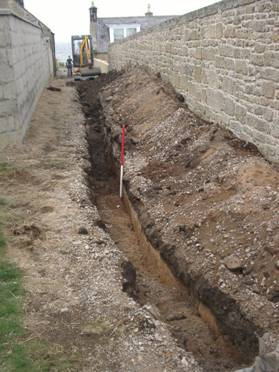Professor Ian Ralston
Projects


A narrow trench 0.3 to 0.5 m in width was machine-cut axially along this lane for some 37.7m starting c. 8.9m from Church Street (Figs 15 and 16). The aim was to identify any ditches or other features potentially associated with the triple banks and ditches. The profile of the Lainie was drawn before excavation began and showed that it lay at approximately 15 m OD. We were informed by neighbours that this path had been scraped by the Council some 18 months previously and that they had encountered loose sandstone rubble.

Fig 15 Cutting a trench down the ‘Lainie’ using a mini-digger driven by Magnus Kirby
Examination of this trench added nothing to the project results. There were no indications of earlier banks or ditches or other features in the narrow cutting, nor were there any artefactual finds.

Fig 16 The Lainie, looking NW, adjacent to the enclosure of the Burghead well: sterile sands and gravels below rich organic-stained deposits.
The trench was backfilled, and further gravel was imported and laid along the Lainie.
The main results of the project are the identification of the vestigial traces of one of the ditches, and part of the adjacent bank, of the external triple system within the garden of the Brae, 35, Grant Street, and the indications that rather more of this system is still perceptible within St Aethan’s Cemetery. Meantime, however, we have no clear indications of the form or scale of the former bank, given the fact that it had been severely damaged probably by the insertion of the soakaway tank for The Brae, although there are indications that it had a revetment of small sandstone slabs and that it was fronted by a cobbled surface, perhaps set on the berm between the bank and the ditch. It must be emphasised, however, that these conclusions are very tentative, since the area of these features that could be reached and examined was diminutive. The unconsolidated nature of the ditch fills that were reached and the associated finds strongly suggested that the definitive infilling of the ditch had occurred when the modern village was laid out and subsequently when the garden adjacent to the Brae was built up and terraced. In the restricted areas that could be safely examined the ditch bottom was not definitely reached, and the only other element that we have at present to suggest its extent is to note that there was no apparent sign of it in the trench cut in the central garden of the Brae. The preferred hypothesis meantime is therefore that the ditch was originally relatively narrow and steep-sided, and that its outer edge lies close to, or under, the wall dividing the NW and central gardens of the Brae.
The writer remains optimistic that it should be possible to date this system if it can be more fully examined once The Brae is made secure. This will depend of examining a less damaged portion of the bank, which should survive further to the SW in the NW garden of the Brae, away from the soakaway. At the same time, a more extensive cutting could be undertaken through the ditch and the cobbled surface on the berm, but this would be dependent on the preliminary demolition of the wall between the NW and central gardens of The Brae.
There is meantime no dating evidence for the wall or ditch as no diagnostic artefacts were recovered from secure contexts, nor were any samples suitable from radiocarbon assay encountered. It is the writer’s belief, however, that the position of the triple system makes better sense topographically as outworks of the Pictish fort on the headland than as an earlier and independent pre-Roman Iron Age system constructed before, and independently from, the ‘courts’ of the Pictish fort itself.
The other trenches examined proved sterile. That in the garden of 22 Church Street clearly lies too far to the NW to have been cut by any of the ditches mapped by Roy. It is perhaps safe to conclude from the narrow cutting along the Lainie that any trace of the wall of the lower ‘court’ is unlikely to survive here.